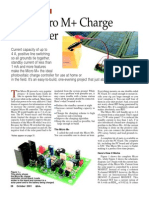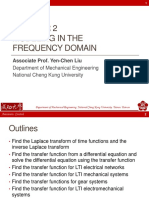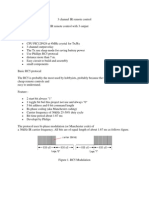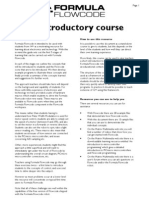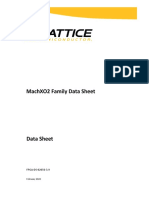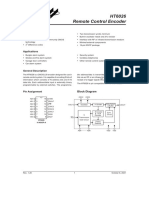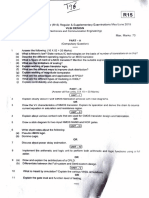Verilog Quick Reference Card
Uploaded by
Hector CabreraVerilog Quick Reference Card
Uploaded by
Hector CabreraQuick Reference for Verilog HDL
Cover design: Sam Starfas Printed by: Technical Printing, Inc. Santa Clara Copyright 1993, 94, 95 Automata Publishing Company
Preface
This is a brief summary of the syntax and semantics of the Verilog Hardware Description Language. The summary is not intended at being an exhaustive list of all the constructs and is not meant to be complete. This reference guide also lists constructs that can be synthesized. For any clarications and to resolve ambiguities please refer to the Verilog Language Referc ence Manual, Copyright 1993 by Open Verilog International, Inc. and synthesis vendors Verilog HDL Reference Manuals.
Quick Reference
for
UNIX is a registered trademark of AT&T Verilog is a registered trademark of Cadence Design Systems, Inc.
Copyright 1993, 94, 95 Automata Publishing Company
Published by Automata Publishing Company
Verilog HDL
In addition to this book, the following HDL books are available from Automata Publishing Company: 1. 2. Digital Design and Synthesis with Verilog HDL Digital Design and Synthesis with VHDL
In addition to the OVI Language Reference Manual, for further examples and explanation of the Verilog HDL, the following text book is recommended: Digital Design and Synthesis With Verilog HDL, Eli Sternheim, Rajvir Singh, Rajeev Madhavan c and Yatin Trivedi, Copyright 1993 by Automata Publishing Company.
Rajeev Madhavan
Rajeev Madhavan AMBIT Design Systems, Inc.
For additional copies of this book or for the source code to the examples, see the order form on the last page of the book. This book may be reproduced or transmitted for distribution provided the copyright notices are retained on all copies. For all other rights please contact the publishers.
Automata Publishing Company 1072 S. Saratoga-Sunnyvale Rd, Bldg A107 San Jose, CA 95129 Phone: 408-255-0705 Fax: 408-253-7916
Released with permission from Automata Publishing Company San Jose, CA 95129
Printed in the United States of America 10 9 8 7 6 5 4 3 2 ISBN 0-9627488-4-6 Copyright 1993, 1994, 1995 Automata Publishing Company.
Quick Reference for Verilog HDL
Quick Reference for Verilog HDL
Quick Reference
for
Use and Copyright
Copyright (c) 1994, 1995 Rajeev Madhavan Copyright (c) 1994, 1995 Automata Publishing Company
Verilog HDL
1.0 Lexical Elements ....................................................................... 1 1.1 Integer Literals .............................................................. 1 1.2 Data Types..................................................................... 1 Registers and Nets ..................................................................... 2 Compiler Directives................................................................... 3 System Tasks and Functions...................................................... 4 Reserved Keywords................................................................... 5 Structures and Hierarchy ........................................................... 6 6.1 Module Declarations ..................................................... 6 6.2 UDP Declarations.......................................................... 7 Expressions and Operators ...................................................... 10 7.1 Parallel Expressions .................................................... 13 7.2 Conditional Statements ............................................... 13 7.3 Looping Statements..................................................... 15 Named Blocks, Disabling Blocks............................................ 16 Tasks and Functions................................................................. 16
Permission to use, copy and distribute this book for any purpose is hereby granted without fee, provided that (i) the above copyright notices and this permission notice appear in all copies, and (ii) the names of Rajeev Madhavan, Automata Publishing and AMBIT Design Systems may not be used in any advertising or publicity relating to this book without the specic, prior written permission of Rajeev Madhavan, Automata Publishing and AMBIT Design Systems. THE BOOK IS PROVIDED "AS-IS" AND WITHOUT WARRANTY OF ANY KIND, EXPRESS, IMPLIED OR OTHERWISE, INCLUDING WITHOUT LIMITATION, ANY WARRANTY OF MERCHANTABILITY OR FITNESS FOR A PARTICULAR PURPOSE. IN NO EVENT SHALL RAJEEV MADHAVAN OR AUTOMATA PUBLISHING OR AMBIT DESIGN SYSTEMS BE LIABLE FOR ANY SPECIAL, INCIDENTAL, INDIRECT OR CONSEQUENTIAL DAMAGES OF ANY KIND, OR ANY DAMAGES WHATSOEVER RESULTING FROM LOSS OF USE, PROFITS, WHETHER OR NOT ADVISED OF THE POSSIBILITY OF DAMAGE, AND ON ANY THEORY OF LIABILITY, ARISING OUT OF OR IN CONNECTION WITH THE USE OF THIS BOOK.
2.0 3.0 4.0 5.0 6.0
7.0
8.0 9.0
10.0 Continous Assignments ........................................................... 18 11.0 Procedural Assignments .......................................................... 18 11.1 Blocking Assignment ................................................ 19 11.2 Non-Blocking Assignment ........................................ 19 12.0 Gate Types, MOS and Bidirectional Switches ........................ 19 12.1 Gate Delays ............................................................... 21 13.0 Specify Blocks......................................................................... 22 14.0 Verilog Synthesis Constructs ................................................... 23 14.1 Fully Supported Constructs....................................... 23 14.2 Partially Supported Constructs.................................. 24 14.3 Ignored Constructs .................................................... 25 14.4 Unsupported Constructs ............................................ 25 15.0 Index ........................................................................................ 27
All rights reserved. This document is intended as a quick R reference guide to the Verilog HDL. Verilog is a registered trademark of Cadence Design Systems, Inc.
Quick Reference for Verilog HDL
Quick Reference for Verilog HDL
Quick Reference for Verilog HDL wire resolves to x. A trireg net behaves like a wire except that when all the drivers of the net are in high impedance (z) state, then the net retains its last driven value. trireg s are used to model capaci-
1.0 Lexical Elements
The language is case sensitive and all the keywords are lower case. White space, namely, spaces, tabs and new-lines are ignored. Verilog has two types of comments: 1. 2. One line comments start with // and end at the end of the line Multi-line comments start with /* and end with */
Time, registers and variable usage
time newtime ; /* time and integer are similar in functionality, time is an unsigned 64-bit used for time variables */ reg [8*14:1] string ; /* This defines a vector with range [msb_expr: lsb_expr] */ initial begin a = 0.5 ; // same b = 1.2E12 ; c = 26.19_60_e-11 // used for string = string newtime =$time; end
tive networks.
wire net1 ; /* wire and tri have same functionality. tri is used for multiple drive internal wire */ trireg (medium) capacitor ; /* small, medium, weak are used for charge strength modeling */
Variable names have to start with an alphabetic character or underscore followed by alphanumeric or underscore characters. The only exception to this are the system tasks and functions which start with a dollar sign. Escaped identiers (identier whose rst characters is a backslash ( \ )) permit non alphanumeric characters in Verilog name. The escaped name includes all the characters following the backslash until the rst white space character.
as 5.0e-1. real variable ; // _s are readability example ;
1.1 Integer Literals
Binary literal 2b1Z Octal literal 2O17 Decimal literal 9 or d9 Hexadecimal literal 3h189 Integer literals can have underscores embedded in them for improved readability. For example, Decimal literal 24_000
2.0 Registers and Nets
A register stores its value from one assignment to the next and is used to model data storage elements.
reg [5:0] din ; /* a 6-bit vector register: individual bits din[5],.... din[0] */
A wand net or triand net operates as a wired and(wand), and a wor net or trior net operates as a wired or (wor), tri0 and tri1 nets model nets with resistive pulldown or pullup devices on them. When a tri0 net is not driven, then its value is 0. When a tri1 net is not driven, then its value is 1. supply0 and supply1 model nets that are connected to the ground or power supply.
wand net2 ; // wired-and wor net3 ; // wired-or triand [4:0] net4 ; // multiple drive wand trior net5 ; // multiple drive wor tri0 net6 ; tri1 net7 ; supply0 gnd ; // logic 0 supply wire supply1 vcc ; // logic 1 supply wire
1.2 Data Types
The values z and Z stand for high impedance, and x and X stand for uninitialized variables or nets with conicting drivers. String symbols are enclosed within double quotes ( string ).and cannot span multiple lines. Real number literals can be either in xed notation or in scientic notation. Real and Integer Variables example
real a, b, c ; // a,b,c to be real
Nets correspond to physical wires that connect instances. The default range of a wire or reg is one bit. Nets do not store values and have to be continuously driven. If a net has multiple drivers (for example two gate outputs are tied together), then the net value is resolved according to its type. Net types
wire wand wor tri0 supply0 trireg tri triand trior tri1 supply1
Memories are declared using register statements with the address range specied as in the following example,
reg [15:0] mem16X512 [0:511]; // 16-bit by 512 word memory // mem16X512[4] addresses word 4 // the order lsb:msb or msb:lsb is not important
The keyword scalared allows access to bits and parts of a bus and vectored allows the vector to be modied only collectively.
wire /* a tri1 /* a vectored [5:0] 6-bit vectored vectored [5:0] 6-bit vectored neta; net */ netb; tri1 */
integer j, k ; // integer variable integer i[1:32] ; // array of integer variables
For a wire, if all the drivers have the same value then the wire resolves to this value. If all the drivers except one have a value of z then the wire resolves to the non z value. If two or more non z drivers have different drive strength, then the wire resolves to the stronger driver. If two drivers of equal strength have different values, then the 2
3.0 Compiler Directives
Verilog has compiler directives which affect the processing of the input 3
Quick Reference for Verilog HDL
Quick Reference for Verilog HDL
Quick Reference for Verilog HDL
les. The directives start with a grave accent ( ) followed by some keyword. A directive takes effect from the point that it appears in the le until either the end of all the les, or until another directive that cancels the effect of the rst one is encountered. For example,
define OPCODEADD 00010
A list of standard system tasks and functions are listed below:
$display, $write - utility to display information $fdisplay, $fwrite - write to le $strobe, $fstrobe - display/write simulation data $monitor, $fmonitor - monitor, display/write information to le $time, $realtime - current simulation time $finish - exit the simulator $stop - stop the simulator $setup - setup timing check $hold, $width- hold/width timing check $setuphold - combines hold and setup $readmemb/$readmemh - read stimulus patterns into memory $sreadmemb/$sreadmemh - load data into memory $getpattern - fast processing of stimulus patterns $history - print command history $save, $restart, $incsave - saving, restarting, incremental saving $scale - scaling timeunits from another module $scope - descend to a particular hierarchy level $showscopes - complete list of named blocks, tasks, modules... $showvars - show variables at scope
6.0 Structures and Hierarchy
Hierarchical HDL structures are achieved by dening modules and instantiating modules. Nested module denitions (i.e. one module denition within another) are not permitted.
This denes a macro named OPCODEADD. When the text OPCODEADD appears in the text, then it is replaced by 00010. Verilog macros are simple text substitutions and do not permit arguments.
`ifdef SYNTH <Verilog code> endif
6.1 Module Declarations
The module name must be unique and no other module or primitive can have the same name. The port list is optional. A module without a port list or with an empty port list is typically a top level module. A macromodule is a module with a attened hierarchy and is used by some simulators for efciency.
module denition example module dff (q,qb,clk,d,rst); input clk,d,rst ; // input signals output q,qb ; // output definition //inout for bidirectionals
If SYNTH is a dened macro, then the Verilog code until endif is inserted for the next processing phase. If SYNTH is not dened macro then the code is discarded.
`include <Verilog file>
The code in <Verilog file> is inserted for the next processing phase. Other standard compiler directives are listed below:
resetall - resets all compiler directives to default values define - text-macro substitution timescale 1ns / 10ps - species time unit/precision ifdef, else, endif - conditional compilation include - le inclusion signed, unsigned - operator selection (OVI 2.0 only) celldefine, endcelldefine - library modules default_nettype wire - default net types unconnected_drive pull0|pull1, nounconnected_drive - pullup or down unconnected ports protect and endprotect - encryption capability protected and endprotected - encryption capability expand_vectornets, noexpand_vectornets, autoexpand_vectornets - vector expansion options remove_gatename, noremove_gatenames - remove gate names for more than one instance remove_netname, noremove_netnames - remove net names for more than one instance
5.0 Reserved Keywords
The following lists the reserved words of Verilog hardware description language, as of OVI LRM 2.0.
and begin case defparam end endmodule for function initial join nand notif0 output primitive pull1 repeat rtranif0 specify supply0 tran tri tri0 wand wire always buf cmos disable endcase endtable force highz0 inout large negedge notif1 parameter pulldown rcmos rnmos rtranif1 specparam supply1 tranif0 triand tri1 weak0 wor assign bufif0 deassign else endfunction endtask forever highz1 input medium nor nmos pmos pullup reg rpmos scalared strong0 table tranif1 trior vectored weak1 attribute bufif1 default endattribute endprimitive event fork if integer module not or posedge pull0 release rtran small strong1 task time trireg wait while
// Net type declarations wire dl,dbl ; // parameter value assignment paramter delay1 = 3, delay2 = delay1 + 1; // delay2 // shows parameter dependance /* Hierarchy primitive instantiation, port connection in this section is by ordered list */ nand #delay1 n1(cf,dl,cbf), n2(cbf,clk,cf,rst); nand #delay2 n3(dl,d,dbl,rst), n4(dbl,dl,clk,cbf), n5(q,cbf,qb), n6(qb,dbl,q,rst); /***** for debuging model initial begin #500 force dff_lab.rst = 1 ; #550 release dff_lab.rst; // upward path referencing end ********/ endmodule
4.0 System Tasks and Functions
System taska are tool specic tasks and functions..
$display( Example of using function); /* display to screen */ $monitor($time, a=%b, clk = %b, add=%h,a,clk,add); // monitor signals $setuphold( posedge clk, datain, setup, hold); // setup and hold checks
Quick Reference for Verilog HDL
Quick Reference for Verilog HDL
Quick Reference for Verilog HDL
Overriding parameters example
module dff_lab; reg data,rst; // Connecting ports by name.(map) dff d1 (.qb(outb), .q(out), .clk(clk),.d(data),.rst(rst)); // overriding module parameters defparam dff_lab.dff.n1.delay1 = 5 , dff_lab.dff.n2.delay2 = 6 ; // full-path referencing is used // over-riding by using #(8,9) delay1=8.. dff d2 #(8,9) (outc, outd, clk, outb, rst); // clock generator always clk = #10 ~clk ; // stimulus ... contd
Sequential Level Sensitive UDPs example Logic/state Representation/transition
dont care (0, 1 or X)
Abbrevation
? (xy)
Transitions from logic x to logic y (xy).
(01), (10), (0x), (1x), (x1), (x0) (?1) .. Transition from (01) Transition from (10) (01), (0X), (X1): positive transition (10), (1x), (x0): negative transition
// latch with async reset primitive latch (q, clock, reset, data); input clock, reset, data ; output q; reg q; initial q = 1b1; // initialization
R or r F or f P or p N or n * or (??) B or b
table // clock reset data ? 1 ? : 0 0 0 : 1 0 ? : 0 0 1 : endtable endprimitive q, ? : ? : ? : ? : q+ 1 ; 0 ; - ; 1 ;
Any transition
binary dont care (0, 1)
Stimulus and Hierarchy example
initial begin: stimuli // named block stimulus clk = 1; data = 1; rst = 0; #20 rst = 1; #20 data = 0; #600 $finish; end initial // hierarchy: downward path referencing begin #100 force dff.n2.rst = 0 ; #200 release dff.n2.rst; end endmodule
Combinational UDPs example
// 3 to 1 mulitplexor with 2 select primitive mux32 (Y, in1, in2, in3, s1, s2); input in1, in2, in3, s1, s2; output Y; table //in1 0 1 ? ? ? ? 0 1 0 1 ? ? in2 ? ? 0 1 ? ? 0 1 ? ? 0 1 in3 ? ? ? ? 0 1 ? ? 0 1 0 1 s1 s2 Y 0 0 : 0 ; 0 0 : 1 ; 1 0 : 0 ; 1 0 : 1 ; ? 1 : 0 ; ? 1 : 1 ; ? 0 : 0 ; ? 0 : 1 ; 0 ? : 0 ; 0 ? : 1 ; 1 ? : 0 ; 1 ? : 1 ;
Sequential Edge Sensitive UDPs example
// edge triggered D Flip Flop with active high, // async set and reset primitive dff (QN, D, CP, R, S); output QN; input D, CP, R, S; reg QN; table // D CP R S : Qtn : Qtn+1 1 (01) 0 0 : ? : 0; 1 (01) 0 x : ? : 0; ? ? 0 x : 0 : 0; 0 (01) 0 0 : ? : 1; // clocked data 0 (01) x 0 : ? : 1; // pessimism ? ? x 0 : 1 : 1; // pessimism 1 (x1) 0 0 : 0 : 0; 0 (x1) 0 0 : 1 : 1; 1 (0x) 0 0 : 0 : 0; 0 (0x) 0 0 : 1 : 1; ? ? 1 ? : ? : 1; // asynch clear ? ? 0 1 : ? : 0; // asynchronous set ? n 0 0 : ? : -; * ? ? ? : ? : -; ? ? (?0) ? : ? : -; ? ? ? (?0): ? : -; ? ? ? ? : ? : x; endtable endprimitive
6.2 User Dened Primitive (UDP) Declarations
The UDPs are used to augment the gate primitives and are dened by truth tables. Instances of UDPs can be used in the same way as gate primitives. There are 2 types of primitives: 1. Sequential UDPs permit initialization of output terminals, which are declared to be of reg type and they store values. Level-sensitive entries take precedence over edge-sensitive declarations. An input logic state Z is interpreted as an X. Similarly, only 0, 1, X or - (unchanged) logic values are permitted on the output. 2. initialized. Combinational UDPs do not store values and cannot be
endtable endprimitive
The following additional abbreviations are permitted in UDP declarations.
Quick Reference for Verilog HDL
Quick Reference for Verilog HDL
Quick Reference for Verilog HDL
7.0 Expressions and Operators
Arithmetic and logical operators are used to build expressions. Expressions perform operation on one or more operands, the operands being vectored or scalared nets, registers, bit-selects, part selects, function calls or concatenations thereof. Unary Expression
<operator> <operand>
All operators associate left to right, except for the ternary operator ?: which associates from right to left. Relational Operators
Equality and Identity Operators Operator
=
Application
c = a ; // assign a to c c == a ; /* is c equal to a returns 1-bit true/false applies for 1 or 0, logic equality, using X or Z operands returns always false hx == h5 returns 0 */ c != a ; // is c not equal to // a, retruns 1-bit true/ // false logic equality a === b ; // is a identical to // b (includes 0, 1, x, z) / // hx === h5 returns 0 a !== b ; // is a not // identical to b returns 1// bit true/false
Operator
<
Application
a < b // is a less than b? // return 1-bit true/false a > b // is a greater than b? a >= b // is a greater than or // equal to b a <= b // is a less than or // equal to b
==
a = !b;
>
Binary and Other Expressions
<operand> <operator> <operand> if (a < b ) // if (<expression>) {c,d} = a + b ; // concatenate and add operator
>= <=
!=
===
Arithmetic Operators Parentheses can be used to change the precedence of operators. For example, ((a+b) * c) Operator precedence Operator *
/
!==
Application
c = a * b ; // multiply a with b c = a / b ; // int divide a by b sum = a + b ; // add a and b diff = a - b ; // subtract b // from a amodb = a % b ; // a mod(b) &
Unary, Bitwise and Reduction Operators Operator
+ -
Operator
+,-,!,~ (unary) *, / % +, - (binary) <<. >> <, < =, >, >= =, ==. != ===, !==
Precedence + Highest %
Application
Unary plus & arithmetic(binary) addition Unary negation & arithmetic (binary) subtraction b = &a ; // AND all bits of a b = |a ; // OR all bits b = ^a ; // Exclusive or all bits of a NAND, NOR, EX-NOR all bits to-gether c = ~& b ; d = ~| a; e = ^c ; bit-wise NOT, AND, OR, EX-OR b = ~a ; // invert a c = b & a ; // bitwise AND a,b e = b | a ; // bitwise OR f = b ^ a ; // bitwise EX-OR bit-wise NAND, NOR, EX-NOR c = a ~& b ; d = a ~| b ; e = a ~^ b ;
Logical Operators Operator && Application
a && b ; // is a and b true? // returns 1-bit true/false a || b ; // is a or b true? // returns 1-bit true/false if (!a) ; // if a is not true c = b ; // assign b to c
| ^ ~&, ~|, ~^ ~,&, |, ^
&, ~& ^, ^~ |, ~| ||
!
&& ||
~&, ~|, ~^
?:
Lowest
10
11
12
Quick Reference for Verilog HDL
Quick Reference for Verilog HDL if .. else ...conditions example always @(rst)// simple if -else if (rst) // procedural assignment q = 0; else // remove the above continous assign deassign q; always @(WRITE or READ or STATUS) begin // if - else - if if (!WRITE) begin out = oldvalue ; end else if (!STATUS) begin q = newstatus ; STATUS = hold ; end else if (!READ) begin out = newvalue ; end end
Quick Reference for Verilog HDL casex statement example casex (state) // treats both x and z as dont care // during comparison : 3b01z, 3b01x, 3b011 // ... match case 3b01x 3b01x: fsm = 0 ; 3b0xx: fsm = 1 ; default: begin // default matches all other occurances fsm = 1 ; next_state = 3b011 ; end endcase
Shift Operators and other Operators Operator
<<
Application
a << 1 ; // shift left a by // 1-bit a >> 1 ; // shift right a by 1 c = sel ? a : b ; /* if sel is true c = a, else c = b , ?: ternary operator */ {co, sum } = a + b + ci ; /* add a, b, ci assign the overflow to co and the result to sum: operator is called concatenation */ b = {3{a}} /* replicate a 3 times, equivalent to {a, a, a} */
>> ?:
{}
casez statement example casez (state) // treats z as dont care during comparison : // 3b11z, 3b1zz, ... match 3b1??: fsm = 0 ; 3b1??: fsm = 0 ; // if MSB is 1, matches 3?b1?? 3b01?: fsm = 1 ; default: $display(wrong state) ; endcase
{{}}
7.1 Parallel Expressions
fork ... join are used for concurrent expression assignments. fork ... join example
initial begin: block fork // This waits for the first event a // or b to occur @a disable block ; @b disable block ; // reset at absolute time 20 #20 reset = 1 ; // data at absolute time 100 #100 data = 0 ; // data at absolute time 120 #120 data = 1 ; join case, casex, casez: case statements are used for switching between multiple selections (if (case1) ... else if (case2) ... else ...). If there are multiple matches only the rst is evaluated. casez treats high impedance values as dont cares and casex
7.3 Looping Statements
forever, for, while and repeat loops example forever // should be used with disable or timing control @(posedge clock) {co, sum} = a + b + ci ; for (i = 0 ; i < 7 ; i=i+1) memory[i] = 0 ; // initialize to 0 for (i = 0 ; i <= bit-width ; i=i+1) // multiplier using shift left and add if (a[i]) out = out + ( b << (i-1) ) ; repeat(bit-width) begin if (a[0]) out = b + out ; b = b << 1 ; // muliplier using a = a << 1 ; // shift left and add end while(delay) begin @(posedge clk) ; ldlang = oldldlang ; delay = delay - 1 ; end
treats both unknown and high-impedance as dont cares.
case statement example module d2X8 (select, out); // priority encode input [0:2] select; output [0:7] out; reg [0:7] out; always @(select) begin out = 0; case (select) 0: out[0] = 1; 1: out[1] = 1; 2: out[2] = 1; 3: out[3] = 1; 4: out[4] = 1; 5: out[5] = 1; 6: out[6] = 1; 7: out[7] = 1; endcase end endmodule
end
7.2 Conditional Statements
The most commonly used conditional statement is the if, if ... else ... conditions. The statement occurs if the expressions controlling the if statement evaluates to true.
13
14
15
Quick Reference for Verilog HDL
Quick Reference for Verilog HDL task Example // task are declared within modules task recv ; output valid ; output [9:0] data ; begin valid = inreg ; if (valid) begin ackin = 1 ; data = qin ; wait(inreg) ; ackin = 0 ; end end // task instantiation always begin: MAIN //named definition if (!qfull) begin recv(new, newdata) ; // call task if (new) begin q[head] = newdata ; head = head + 1 ; end end else disable recv ; end // MAIN function Example
Quick Reference for Verilog HDL
8.0 Named Blocks, Disabling Blocks
Named blocks are used to create hierarchy within modules and can be used to group a collection of assignments or expressions. disable statement is used to disable or de-activate any named block, tasks or modules. Named blocks, tasks can be accessed by full or reference hierarchy paths (example dff_lab.stimuli).Named blocks can have local variables. Named blocks and disable statement example
initial forever @(posedge reset) disable MAIN ; // disable named block // tasks, modules can also be disabled always begin: MAIN // defining named blocks if (!qfull) begin #30 recv(new, newdata) ; // call task if (new) begin q[head] = newdata ; head = head + 1 ; // queue end end else disable recv ; end // MAIN
10.0 Continous Assignments
Continous assignments imply that whenever any change on the RHS of the assignment occurs, it is evaluated and assigned to the LHS. These assignments thus drive both vector and scalar values onto nets. Continous assignments always implement combinational logic (possibly with delays). The driving strengths of a continous assignment can be specied by the user on the net types.
Continous assignment on declaration
/* since only one net15 declaration exists in a given module only one such declarative continous assignment per signal is allowed */ wire #10 (atrong1, pull0) net15 = enable ; /* delay of 10 for continous assignment with strengths of logic 1 as strong1 and logic 0 as pull0 */
Continous assignment on already declared nets
assign #10 net15 = enable ; assign (weak1, strong0) {s,c} = a + b ;
11.0 Procedural Assignments
Assignments to register data types may occur within always, initial, task and functions . These expressions are controlled by triggers which cause the assignments to evaluate. The variables to which the expressions are assigned must be made of bit-select or partselect or whole element of a reg, integer, real or time. These triggers can be controlled by loops, if, else ... constructs. assign and deassign are used for procedural assignments and to remove the continous assignments.
module dff (q,qb,clk,d,rst); output q, qb; input d, rst, clk; reg q, qb, temp; always #1 qb = ~q ; // procedural assignment always @(rst) // procedural assignment with triggers if (rst) assign q = temp; else deassign q; always @(posedge clk) temp = d; endmodule
9.0 Tasks and Functions
Tasks and functions permit the grouping of common procedures and then executing these procedures from different places. Arguments are passed in the form of input/inout values and all calls to functions and tasks share variables. The differences between tasks and functions are Tasks Permits time control Can have zero or more arguments Does not return value, assigns value to outputs Can have output arguments, permits #, @, ->, wait, task calls. Functions Executes in one simulation time Require at least one input Returns a single value, no special output declarations required Does not permit outputs, #, @, ->, wait, task calls
module foo2 (cs, in1, in2, ns); input [1:0] cs; input in1, in2; output [1:0] ns; function [1:0] generate_next_state; input[1:0] current_state ; input input1, input2 ; reg [1:0] next_state ; // input1 causes 0->1 transition // input2 causes 1->2 transition // 2->0 illegal and unknown states go to 0 begin case (current_state) 2h0 : next_state = input1 ? 2h1 : 2h0 ; 2h1 : next_state = input2 ? 2h2 : 2h1 ; 2h2 : next_state = 2h0 ; default: next_state = 2h0 ; endcase generate_next_state = next_state; end endfunction // generate_next_state assign ns = generate_next_state(cs, in1,in2) ; endmodule
16
17
18
Quick Reference for Verilog HDL force and release are also procedural assignments. However, they can force or release values on net data types and registers.
Quick Reference for Verilog HDL
Quick Reference for Verilog HDL
The following strength denitions exists Gate Types
Component
11.1 Blocking Assignment
module adder (a, b, ci, co, sum,clk) ; input a, b, ci, clk ; output co, sum ; reg co, sum; always @(posedge clk) // edge control // assign co, sum with previous value of a,b,ci {co,sum} = #10 a + b + ci ; endmodule
Gates Allows strengths Allows strengths No strengths No strengths, non resistive No strengths, resistive Allows strengths
and, nand, or, nor,xor, xnor buf, not buif0,bufif1 notif0,notif1 nmos,pmos,cmos, rnmos,rpmos,rcmos tran, tranif0, tranif1 rtran,rtranif0, rtranif1 pullup pulldown
4 drive strengths (supply, strong, pull,
weak)
3 capacitor strengths (large, medium, small) 1 high impedance state highz
Three State Drivers MOS Switches Bi-directional switches
The drive strengths for each of the output signals are Strength of an output signal with logic value 1
supply1, strong1, pull1, large1, weak1, highz1
11.2 Non-Blocking Assignment
Allows scheduling of assignments without blocking the procedural flow. Blocking assignments allow timing control which are delays, whereas, non-blocking assignments permit timing control which can be delays or event control. The non-blocking assignment is used to avoid race conditions and can model RTL assignments.
/* assume a = 10, b= 20 c = 30 d = 40 at start of block */ always @(posedge clk) begin:block a <= #10 b ; b <= #10 c ; c <= #10 d ; end /* at end of block + 10 time units, a = 20, b = 30, c = 40 */
Strength of an output signal with logic value 0
supply0, strong0, pull0, large0, weak0, highz0
Gates, switch types, and their instantiations
cmos i1 (out, datain, ncontrol, pcontrol); nmos i2 (out, datain, ncontrol); pmos i3 (out, datain, pcontrol); pullup (neta) (netb); pulldown (netc); nor i4 (out, in1, in2, ...); and i5 (out, in1, in2, ...); nand i6 (out, in1, in2, ...); buf i7 (out1, out2, in); bufif1 i8 (out, in, control); tranif1 i9 (inout1, inout2, control);
Logic 0
supply0 strong0 pull0 large weak0 medium small highz0 Su0 St0 Pu0 La0 We0 Me0 Sm0 HiZ0
Logic 1
supply1 strong1 pull1 large weak1 medium small highz1 Su1 St1 Pu1 La1 We1 Me1 Sm1 HiZ0
Strength
7 6 5 4 3 2 1 0
12.0 Gate Types, MOS and Bidirectional Switches
Gate declarations permit the user to instantiate different gate-types and assign drive-strengths to the logic values and also any delays
Gate level instantiation example
// Gate level instantiations nor (highz1, strong0) #(2:3:5) (out, in1, in2); // instantiates a nor gate with out // strength of highz1 (for 1) and // strong0 for 0 #(2:3:5) is the // min:typ:max delay pullup1 (strong1) net1; // instantiates a logic high pullup cmos (out, data, ncontrol, pcontrol); // MOS devices
12.1 Gate Delays
The delays allow the modeling of rise time, fall time and turn-off delays for the gates. Each of these delay types may be in the min:typ:max format. The order of the delays are #(trise, tfall, tturnoff). For example,
<gate-declaration> ::= <component> <drive_strength>? <delay>? <gate_instance> <,?<gate_instance..>> ;
nand #(6:7:8, 5:6:7, 122:16:19) (out, a, b);
19
20
21
Quick Reference for Verilog HDL
Quick Reference for Verilog HDL
Quick Reference for Verilog HDL
Verilog
Delay #(delay) #(delay, delay)
Model
min:typ:max delay rise-time delay, fall-time delay, each delay can be with min:typ:max rise-time delay, fall-time delay and turn-off delay, each min:typ:max
disable
Synthesis Constructs
The following is a set of Verilog constructs that are supported by most synthesis tools at the time of this writing. To prevent variations in supported synthesis constructs from tool to tool, this is the least common denominator of supported constructs. Tool reference guides cover specic constructs.
function, endfunction if, else, else if input, output, inout wire, wand, wor, tri integer, reg macromodule, module parameter supply0, supply1 task, endtask
#(delay, delay, delay)
For trireg , the decay of the capacitive network is modeled using the rise-time delay, fall-time delay and charge-decay. For example,
trireg (large) #(0,1,9) capacitor // charge strength is large // decay with tr=0, tf=1, tdecay=9
14.0 Verilog Synthesis Constructs
Since it is very difcult for the synthesis tool to nd hardware with exact delays, all absolute and relative time declarations are ignored by the tools. Also, all signals are assumed to be of maximum strength (strength 7). Boolean operations on X and Z are not permitted. The constructs are classied as Fully supported constructs Constructs that are supported as defined in the Verilog Language Reference Manual Partially supported Constructs supported with restrictions on them Ignored constructs Constructs that are ignored by the synthesis tool
posedge, negedge
14.2 Partially Supported Constructs
13.0 Specify Blocks
A specify block is used to specify timing information for the module in which the specify block is used. Specparams are used to declare delay constants, much like regular parameters inside a module, but unlike module parameters they cannot be overridden. Paths are used to declare time delays between inputs and outputs. Timing Information using specify blocks
specify // similar to defparam, used for timing specparam delay1 = 25.0, delay2 = 24.0; // edge sensitive delays -- some simulators // do not support this (posedge clock) => (out1 +: in1) = (delay1, delay2) ; // conditional delays if (OPCODE == 3h4) (in1, in2 *> out1) = (delay1, delay2) ; // +: implies edge-sensitive +ve polarity // -: implies edge sensitive -ve polarity // *> implies multiple paths // level sensitive delays if (clock) (in1, in2 *> out1, out2) = 30 ; // setuphold $setuphold(posedge clock &&& reset, in1 &&& reset, 3:5:6, 2:3:6); (reset *> out1, out2) = (2:3:5,3:4:5); endspecify
Construct
*, /, %
Constraints when both operands constants, or 2nd operand power of 2. only edge-triggered events. bounded by static variables: only use + or - to index. only with always @ . Combinational and edge-sensitive user dened primitives are often supported. limitations on usage with blocking assignment. gate types supported without X or Z constructs
always for
Unsupported constructs Constructs which if used, may cause the synthesis tool to not accept the Verilog input or may cause different results between synthesis and simulation.
primitive, endprimitive table,endtable <=
14.1 Fully Supported Constructs
<module instantiation, with named and positional notations> <integer data types, with all bases> <identifiers> <subranges and slices on right-hand side of assignment> <continuous assignments> >>, << , ? : {} assign (procedural and declarative), begin, end case, casex, casez, endcase default and, nand, or, nor, xor, xnor, buf, not, buif0, bufif1,notif0, notif1 !, &&, ||, ~, &, |, ^, ^~, ~^, ~&, ~|, +, - , <, >, <=, >=, ==, !=
operators supported without X or Z constructs
22
23
24
Quick Reference for Verilog HDL
Quick Reference for Verilog HDL
Quick Reference for Verilog HDL
14.3 Ignored Constructs
<intra-assignment timing controls> <delay specifications> scalared, vectored small, large, medium specify time (some tools treat these as integers) weak1, weak0, highz0, highz1, pull0, pull1 $keyword (some tools use these to set synthesis constraints) wait (some tools support wait with a bounded condition)
- NOTES -
- NOTES -
14.4 Unsupported Constructs
<assignment with variable used as bit select on LHS of assignment> <global variables> ===, !== cmos, nmos, rcmos, rnmos, pmos, rpmos deassign defparam event force fork, join forever, while initial pullup, pulldown release repeat rtran, tran, tranif0, tranif1, rtranif0, rtranif1 table, endtable, primitive, endprimitive
All rights reserved. Please send any feedback to the author. Verilog R is a registered trademark of Cadence Design Systems, Inc.
25
26
26b
Quick Reference for Verilog HDL
Quick Reference for Verilog HDL
Symbols
$display, $write 5 $fdisplay, $fwrite 5 $finish 5 $getpattern 5 $history 5 $hold, $width 5 $monitor, $fmonitor 5 $readmemb, $readmemh 5 $save, $restart, $incsave 5 $scale 5 $scope, $showscopes 5 $setup, $setuphold 5 $showvars 5 $sreadmemb/$sreadmemh 5 $stop 5 $strobe, $fstrobe 5 $time, $realtime 5 /* */ 1 // 1 autoexpand_vectornets 4 celldefine, endcelldefine 4 default_nettype 4 define 4 expand_vectornets 4 noexpand_vectornets 4 ifdef, else, endif 4 include 4 nounconnected_drive 4 protect, endprotect 4 protected, endprotected 4 remove_gatename 4 noremove_gatenames 4 remove_netname 4 noremove_netnames 4 resetall 4 signed, unsigned 4 timescale 4 unconnected_drive 4
C
case 14 casex 14 casez 14 compiler directives 3 continous assignments 18
O
Operator precedence 10
V
vectored 3
Verilog HDL Publications Order Form
Automata Publishing Company 1072 S. Saratoga Sunnyvale Rd., Bldg. A107, Ste 325, San Jose CA-95129. U.S.A Phone: 408-255-0705 Fax: 408-253-7916
Verilog Publications: Publication 1.Digital Design and Synthesis with Verilog HDL Publication 2.Digital Design and Synthesis with Verilog HDL+ Source diskette + Quick Reference for Verilog HDL Name: ________________________ Title: _______________ Company: _________________________________________ Address: __________________________________________ __________________________________________________ City: _____________________________________________ State: _______________________ Zip: ________________ Ph: __________________________ Fax: ________________ Publication
Quantity Price per book (see below) Shipping (see below) Salex Tax (CA residents only, @current rate) Total amount due
P
Partially Supported Synthesis Constructs 24 procedural assignments 18 pulldown 3 pullup 3
W
wait 16 wand 3 while 15 wire 2 wor 3
D
delays 21 disable 16
R
reg, register 2 Relational Operators 11 repeat 15 reserved words 5
X
x, X 1
E
Equality Operators 12 Escaped identifiers 1 Expressions 10
Z
z, Z 1
F
for 15 forever 15 fork ... join 13 Fully Supported Synthesis Constructs 23 function 16
S
scalared 3 Sequential edge sensitive UDP 9 Sequential level sensitive UDP 9 Shift, other Operators 13 specify block 22 specparam 22 String symbols 1 supply0 3 supply1 3 switch types 20 Synthesis Constructs 23 Synthesis Ignored Constructs 25 Synthesis Unsupported Constructs 25
G
Gate declaration 19 gate-types 19
I
if, if ... else 13 Integer literals 1 Identity Operators 12
P.O Number if any: _____________________________________ Charge my Visa/MC/AmExp. # ___________________________ Expires on: _____________________________________
Publication Qty-Price/copy 1-4 5-9 10-19 20- 44 45 - 99 100 - 500 1 (US$) 59.95 54.95 49.95 44.95 39.95 34.95 3.00 2 (US$) 65.95 60.95 54.95 49.95 44.45 39.00 3.00
T
task 16 tri0 3 tri1 3 triand 3 trior 3 trireg 3
L
Logical Operators 11
A
Arithmetic Operators 11
M
Memories 3 module 6
U
UDP 7 Unary Expression 10 Unary, Bitwise and Reduction Operators 12
B
Binary Expressions 10 blocking assignment 19
N
Named blocks 16 Nets 2 non-blocking assignments 19 27
Shipping/copy
For large volume discounts contact Automata Publishing Company
28
You might also like
- M. Bertero, P. Boccacci, Christine de Mol - Introduction To Inverse Problems in Imaging-CRC Press (2021)No ratings yetM. Bertero, P. Boccacci, Christine de Mol - Introduction To Inverse Problems in Imaging-CRC Press (2021)358 pages
- Introduction To Neural Networks by Ingrid RusselNo ratings yetIntroduction To Neural Networks by Ingrid Russel16 pages
- ENGR 3050 Capacitive Displacement Sensor Lab IntroductionNo ratings yetENGR 3050 Capacitive Displacement Sensor Lab Introduction3 pages
- A Computational Tool For Predicting Hybrid Rocket Motor Performance100% (2)A Computational Tool For Predicting Hybrid Rocket Motor Performance10 pages
- Map Creation and Position Correction For An Off The Shelf0% (1)Map Creation and Position Correction For An Off The Shelf119 pages
- Ch. 8 Lecture Slides For Chenming Hu Book: Modern Semiconductor Devices For ICsNo ratings yetCh. 8 Lecture Slides For Chenming Hu Book: Modern Semiconductor Devices For ICs43 pages
- 8051 Microcontroller and Embedded Systems: A Six Week Training and Project Report OnNo ratings yet8051 Microcontroller and Embedded Systems: A Six Week Training and Project Report On35 pages
- Plasma Waves and Instabilities Lecture Notes (Under Development)No ratings yetPlasma Waves and Instabilities Lecture Notes (Under Development)170 pages
- Ramon Garcia-Hernandez, Michel Lopez-Franco, Edgar N. Sanchez, Alma Y. Alanis, Jose A. Ruz-Hernandez Auth. Decentralized Neural Control Application To RoboticsNo ratings yetRamon Garcia-Hernandez, Michel Lopez-Franco, Edgar N. Sanchez, Alma Y. Alanis, Jose A. Ruz-Hernandez Auth. Decentralized Neural Control Application To Robotics121 pages
- An Efficient Procedure For Narrowband Bandpass Filter DesignNo ratings yetAn Efficient Procedure For Narrowband Bandpass Filter Design7 pages
- Fdocuments - in Rocket Propulsion Prof K Ramamurthi Department of Nptelacinreviewedpdfs112106073lec35pdfNo ratings yetFdocuments - in Rocket Propulsion Prof K Ramamurthi Department of Nptelacinreviewedpdfs112106073lec35pdf28 pages
- Robotics - Sensors and Methods For Autonomous Mobile Robot PNo ratings yetRobotics - Sensors and Methods For Autonomous Mobile Robot P204 pages
- Blocking Oscillator: Resistor Transformer Transistor Duty-Cycle Leds Red-Eye EffectNo ratings yetBlocking Oscillator: Resistor Transformer Transistor Duty-Cycle Leds Red-Eye Effect5 pages
- Microwave Engineering 4 Edition CoverageNo ratings yetMicrowave Engineering 4 Edition Coverage3 pages
- PUMA-560 Robot Manipulator Position Sliding Mode Control Methods Using MATLAB/SIMULINK and Their Integration Into Graduate/Undergraduate Nonlinear Control, Robotics and MATLAB CoursesNo ratings yetPUMA-560 Robot Manipulator Position Sliding Mode Control Methods Using MATLAB/SIMULINK and Their Integration Into Graduate/Undergraduate Nonlinear Control, Robotics and MATLAB Courses45 pages
- Ch.4 Lecture Slides For Chenming Hu Book: Modern Semiconductor Devices For ICs100% (1)Ch.4 Lecture Slides For Chenming Hu Book: Modern Semiconductor Devices For ICs79 pages
- Plasma Nitriding of Stainless Steels at Low TemperaturesNo ratings yetPlasma Nitriding of Stainless Steels at Low Temperatures7 pages
- Kinematic Simulation of Staubli TX40 Robot-ICMNo ratings yetKinematic Simulation of Staubli TX40 Robot-ICM6 pages
- Solutions Manual to accompany An Introduction to Numerical Methods and AnalysisFrom EverandSolutions Manual to accompany An Introduction to Numerical Methods and Analysis5/5 (1)
- Learn Digital and Microprocessor Techniques On Your Smartphone: Portable Learning, Reference and Revision Tools.From EverandLearn Digital and Microprocessor Techniques On Your Smartphone: Portable Learning, Reference and Revision Tools.No ratings yet
- Silica Optical Fiber Technology for Devices and Components: Design, Fabrication, and International StandardsFrom EverandSilica Optical Fiber Technology for Devices and Components: Design, Fabrication, and International StandardsNo ratings yet
- Guidelines FOR Part Average Testing: Automotive Electronics CouncilNo ratings yetGuidelines FOR Part Average Testing: Automotive Electronics Council12 pages
- Electronics and Communication Engineering - 2010No ratings yetElectronics and Communication Engineering - 201045 pages
- Anti-Spatter Inductive Prox: Ordering InformationNo ratings yetAnti-Spatter Inductive Prox: Ordering Information9 pages
- FPGA DS 02056 3 9 MachXO2 Family Data SheetNo ratings yetFPGA DS 02056 3 9 MachXO2 Family Data Sheet122 pages
- CD54/74HC4059: High-Speed CMOS Logic CMOS Programmable Divide-by-N CounterNo ratings yetCD54/74HC4059: High-Speed CMOS Logic CMOS Programmable Divide-by-N Counter7 pages
- I/O & Esd Design: Byron Krauter, Ibm Mark McdermottNo ratings yetI/O & Esd Design: Byron Krauter, Ibm Mark Mcdermott85 pages
- Custom IC Design Services: What Makes Us Stand OutNo ratings yetCustom IC Design Services: What Makes Us Stand Out2 pages
- 2 Datasheet Detector Tactil de Teclado TTP223No ratings yet2 Datasheet Detector Tactil de Teclado TTP2239 pages
- VTU - MTECH - VLSI Design& Embedded Systems Syllabus - RevisedNo ratings yetVTU - MTECH - VLSI Design& Embedded Systems Syllabus - Revised37 pages
- University of California, Berkeley College of Engineering Department of Electrical Engineering and Computer Sciences Elad Alon Homework #4 EECS141No ratings yetUniversity of California, Berkeley College of Engineering Department of Electrical Engineering and Computer Sciences Elad Alon Homework #4 EECS1412 pages
- M. Bertero, P. Boccacci, Christine de Mol - Introduction To Inverse Problems in Imaging-CRC Press (2021)M. Bertero, P. Boccacci, Christine de Mol - Introduction To Inverse Problems in Imaging-CRC Press (2021)
- ENGR 3050 Capacitive Displacement Sensor Lab IntroductionENGR 3050 Capacitive Displacement Sensor Lab Introduction
- A Computational Tool For Predicting Hybrid Rocket Motor PerformanceA Computational Tool For Predicting Hybrid Rocket Motor Performance
- Map Creation and Position Correction For An Off The ShelfMap Creation and Position Correction For An Off The Shelf
- Ch. 8 Lecture Slides For Chenming Hu Book: Modern Semiconductor Devices For ICsCh. 8 Lecture Slides For Chenming Hu Book: Modern Semiconductor Devices For ICs
- 8051 Microcontroller and Embedded Systems: A Six Week Training and Project Report On8051 Microcontroller and Embedded Systems: A Six Week Training and Project Report On
- Plasma Waves and Instabilities Lecture Notes (Under Development)Plasma Waves and Instabilities Lecture Notes (Under Development)
- Ramon Garcia-Hernandez, Michel Lopez-Franco, Edgar N. Sanchez, Alma Y. Alanis, Jose A. Ruz-Hernandez Auth. Decentralized Neural Control Application To RoboticsRamon Garcia-Hernandez, Michel Lopez-Franco, Edgar N. Sanchez, Alma Y. Alanis, Jose A. Ruz-Hernandez Auth. Decentralized Neural Control Application To Robotics
- An Efficient Procedure For Narrowband Bandpass Filter DesignAn Efficient Procedure For Narrowband Bandpass Filter Design
- Fdocuments - in Rocket Propulsion Prof K Ramamurthi Department of Nptelacinreviewedpdfs112106073lec35pdfFdocuments - in Rocket Propulsion Prof K Ramamurthi Department of Nptelacinreviewedpdfs112106073lec35pdf
- Robotics - Sensors and Methods For Autonomous Mobile Robot PRobotics - Sensors and Methods For Autonomous Mobile Robot P
- Blocking Oscillator: Resistor Transformer Transistor Duty-Cycle Leds Red-Eye EffectBlocking Oscillator: Resistor Transformer Transistor Duty-Cycle Leds Red-Eye Effect
- PUMA-560 Robot Manipulator Position Sliding Mode Control Methods Using MATLAB/SIMULINK and Their Integration Into Graduate/Undergraduate Nonlinear Control, Robotics and MATLAB CoursesPUMA-560 Robot Manipulator Position Sliding Mode Control Methods Using MATLAB/SIMULINK and Their Integration Into Graduate/Undergraduate Nonlinear Control, Robotics and MATLAB Courses
- Ch.4 Lecture Slides For Chenming Hu Book: Modern Semiconductor Devices For ICsCh.4 Lecture Slides For Chenming Hu Book: Modern Semiconductor Devices For ICs
- Plasma Nitriding of Stainless Steels at Low TemperaturesPlasma Nitriding of Stainless Steels at Low Temperatures
- Solutions Manual to accompany An Introduction to Numerical Methods and AnalysisFrom EverandSolutions Manual to accompany An Introduction to Numerical Methods and Analysis
- Learn Digital and Microprocessor Techniques On Your Smartphone: Portable Learning, Reference and Revision Tools.From EverandLearn Digital and Microprocessor Techniques On Your Smartphone: Portable Learning, Reference and Revision Tools.
- Silica Optical Fiber Technology for Devices and Components: Design, Fabrication, and International StandardsFrom EverandSilica Optical Fiber Technology for Devices and Components: Design, Fabrication, and International Standards
- Computer Aided Design of Electrical MachinesFrom EverandComputer Aided Design of Electrical Machines
- Guidelines FOR Part Average Testing: Automotive Electronics CouncilGuidelines FOR Part Average Testing: Automotive Electronics Council
- CD54/74HC4059: High-Speed CMOS Logic CMOS Programmable Divide-by-N CounterCD54/74HC4059: High-Speed CMOS Logic CMOS Programmable Divide-by-N Counter
- I/O & Esd Design: Byron Krauter, Ibm Mark McdermottI/O & Esd Design: Byron Krauter, Ibm Mark Mcdermott
- Custom IC Design Services: What Makes Us Stand OutCustom IC Design Services: What Makes Us Stand Out
- VTU - MTECH - VLSI Design& Embedded Systems Syllabus - RevisedVTU - MTECH - VLSI Design& Embedded Systems Syllabus - Revised
- University of California, Berkeley College of Engineering Department of Electrical Engineering and Computer Sciences Elad Alon Homework #4 EECS141University of California, Berkeley College of Engineering Department of Electrical Engineering and Computer Sciences Elad Alon Homework #4 EECS141




















